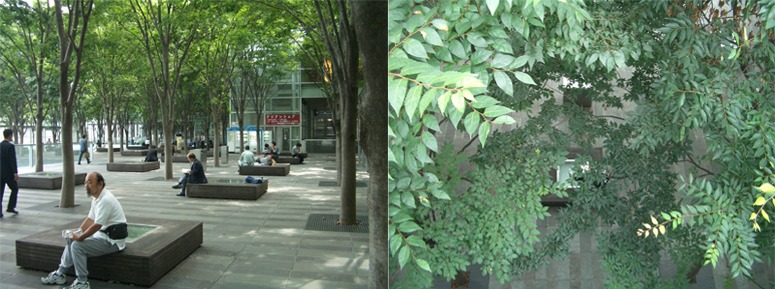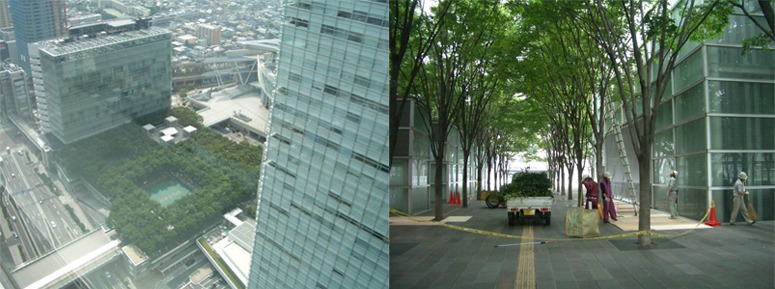Some years ago now I visited Japan – a country in which I had previously lived for a good many years – in order to write an article for Landscape Architecture Magazine. It was 2004, and ASLA had given its Design Award of Merit to Saitama Plaza, a collaboration between Peter Walker and Yoji Sasaki, who had kindly agreed to an interview.
Sitting in his office in Osaka he reminisced on their first encounter: a meeting between teacher and student, as Sasaki was then attending the Department of Landscape Architecture at the University of California at Berkeley, where Walker was Head of Department. He was offered a challenge: Japan had a remarkable landscape tradition, but who was carrying that tradition forward, interpreting and reinventing it for the late twentieth century? With the benefit of hindsight perhaps that was one of the defining moments in Sasaki’s career. You can judge for yourselves here.
Our interview over, he returned to his earlier topic but this time turned the tables on me. Who in the United Kingdom was carrying on the grand landscape tradition of Capability Brown, et al? For him, and perhaps for many others, this represented the zenith of British landscape design.
I have pondered his question ever since then and it is one that I pose here.



Wow. Last night the was a programme on the exclusion zone and areas adjacent to it in Fukushima. According to the programme radiation contamination will remain in the soil for up to 50 years. If this is so, a system like the skyforest which hovers above the contaminated ground, but introduces a new soil layer, may be an ideal solution for enabling both urban and agricultural land re-use within this 50 year period?
On the quesiton of Capability Brown, perhaps Tom is best placed to comment.
Modern Japanese cities are just that: International Modern. But some Japanese garden designers have done a remarkable job in carrying forward the tradition without resorting to pastische. My evidence for this belief comes mainly from the design details in The Modern Japanese Garden by Michiko Rico Nose (2005). Each time I look at the book, my three thoughts about the designs are (1) they are beautiful (2) they are modern (3) they are Japanese. I have not visited Saitama Plaza but, from the photographs, feel more confident about it spurring thoughts ‘(1)’ and ‘(2)’ than about ‘(3)’.
BUT I also think the designs in The Modern Japanese Garden are lacking something – a deep-set design philosophy.
With regard to the UK, I think that trained landscape architects are particularly weak in design theory and design philosophy. (I share in the blame for this, of course, having spent probably-too-many years as as teacher.) When I first wrote about the problem, in 1986, the three designers I drew attention to, for begining to rise above the problem, were Geoffrey Jellicoe, Ian Hamilton Finlay and Charles Jencks. Having recently revised (but not yet published) the 1986 book, I was not able to add much to the list. Why should this be so? I would rather give an anthropological answer than a philosophical answer: the landscape profession made a fundamental error when it divorced itself from garden design. The error was philosophical, organisational and professional. Gardens can be, and are, crucibles for the design process. You can use them for wilful experimentation in a way that is rarely possible when your clients are (1) not the owners of the properties they develop (2) not the users of the properties they develop (3) often short-term employees of the organisations which develop land. This applies to almost all large residential, industrial, commercial and public-sector developments.
Yes…Perhaps the contaminated ground will need to be sealed in some form also so that the
top soil is not carried by the wind to other areas of Japan.
Another interesting Japanese practitioner in the UK (you may already know) is the Art Gardener, Takeshi Nagasaki. [ http://www.n-tree.jp/profile/CV_TN_e.pdf ]
I agree with Tom in that there is nothing particularly “Japanese” about the design of Saitama Plaza, except perhaps in the attention to detail. Technically, it is an impressive achievement though, and sitting under the trees during a typical Japanese summer (+30 degrees with intense humidity) is a delight. However, I’m not sure how applicable it would be to other schemes with more modest budgets, or covering larger areas. Many of Sasaki’s schemes are at a much smaller scale and perhaps demonstrate more of a “Japanese” aesthetic:
http://www.cornerstonesonoma.com/explore/projects/yoji-sasaki/
With reference to the comment about teaching of design theory and philosophy, our local Landscape Institute branch recently held a presentation by Eelco Hooftman of GROSS.MAX. I forget the context now, but he responded to an audience question about the practice by saying that on balance he preferred to employ architects (perhaps because they have a stronger grounding in theory and philosophy?) which I thought was interesting given that he is also a teacher of landscape architecture (at the Edinburgh College of Art). He did however then go on to say that all 15 of his current employees were in fact landscape architects!
Many landscape architects do of course carry out garden design. So, is it too late for a rapprochement between what are, after all, but two sides of one coin? There are also many landscape practices carrying out work that I admire; and some, such as for example, GROSS.MAX. have a distinct leaning towards theory and philosophy (as evidenced by Eelco’s presentation). But is landscape design in this country always destined to be known primarily as the source of the English landscape garden? I suspect that this might just be the case!
Hmmm. I differ in my assessment of the ‘Japanese-ness’ of the project, and suggest that Yoji Sasaki’s influence can best be felt in the zen like simplicity of the concept and its execution.
Thinking about garden design Tom, perhaps the garden is to the landscape architect what the house is to an architect – the crucible of design innovation?
I have to say, having been to Tokyo, that landscaping and garden design is part of their culture. People take pride in even the smallest of gardens.
Speaking of landscape architects and gardens, do you think if you were commissioning a landscape architect you would want to see how they had designed their own garden? Would it tell you anything about their skill as a designer? My own garden, whilst reasonably tidy, has little to distinguish it from my neighbours’ and I somehow seem to find very little time to spend in it – with corresponding results (or lack thereof!)
Noel Kingsbury has published a book entitled “Garden Designers at Home” – has anyone read this? No doubt the featured gardens are all amazing!
There is a famous saying that the plumbers tap is always dripping because he is too busy fixing everyone else’s tap and too tired to do his own when he gets home!
In architecture however, often the first commission and many times the first design award is for the architect’s (or there parent’s) own home. (The client generously gives them total creative freedom!)
The Rose Seidler House was an important first work in Harry Seidler’s oeuvre.
[ http://www.smh.com.au/ftimages/2006/03/09/1141701620409.html ]
Thankyou for the the information on Noel Kingsbury’s book. Perhaps Tom has done a book review?
If you saw ‘my’ garden, you might well decide to commission me for a planting design – but you would be making a mistake: it is my wife’s work! Most definitely I will be explaining this by the Plumbers Tap analogy in future.
Ha Ha, my own garden has been a 10 year work in progress. Not that I don’t tend to it but I keep changing it up. I have to say though I like to keep things as native as possible and would like to think I do my bit to carry on the tradition of natural irish landscaping with contemporary twists and modern adaptations. My pet hate is palm trees, completely out of place in our harsh Irish Climate.